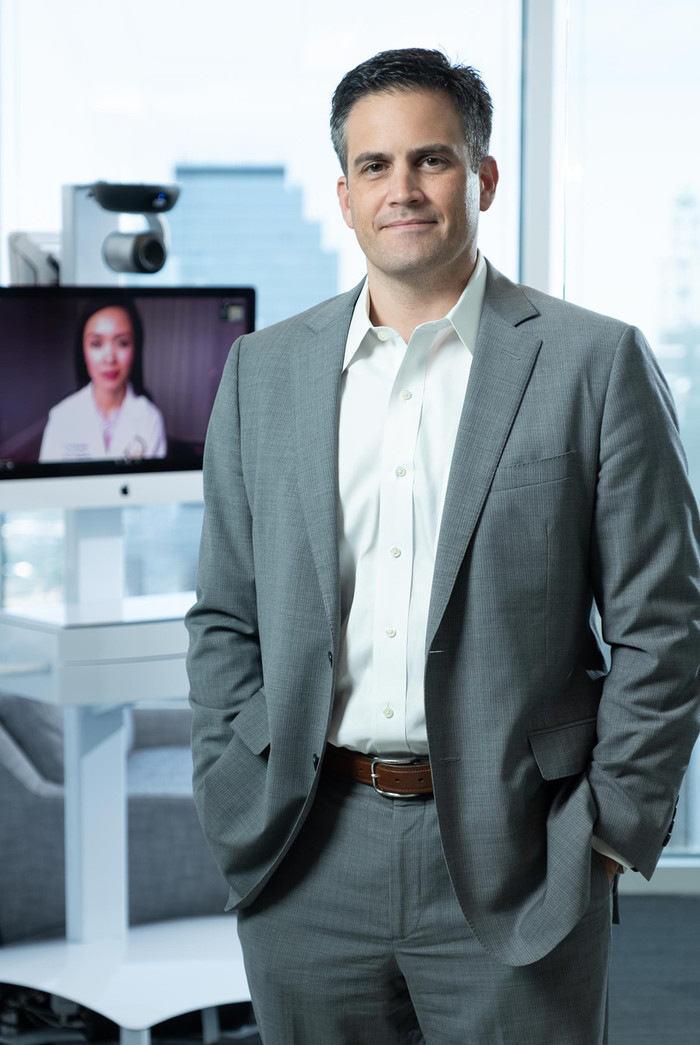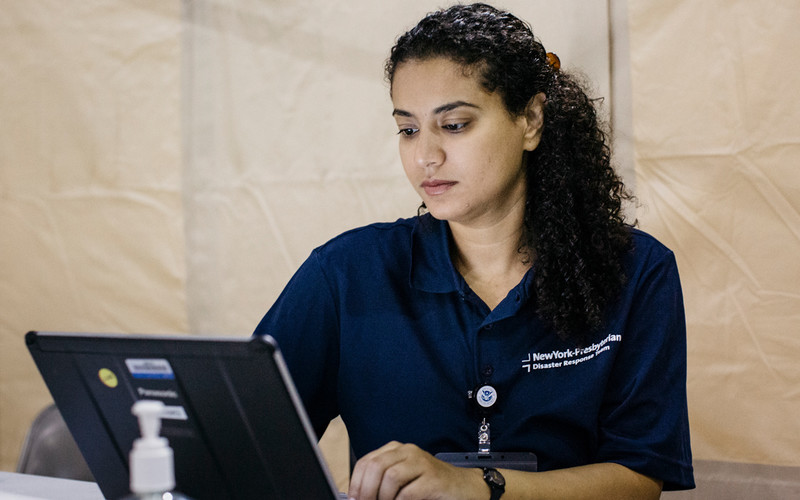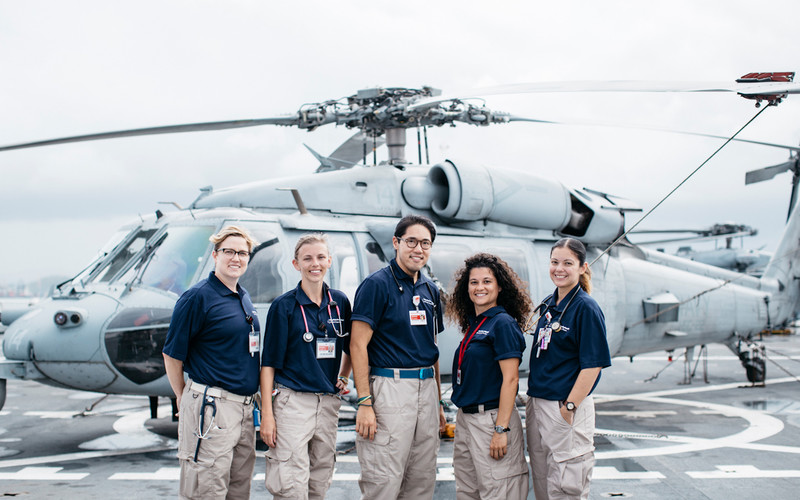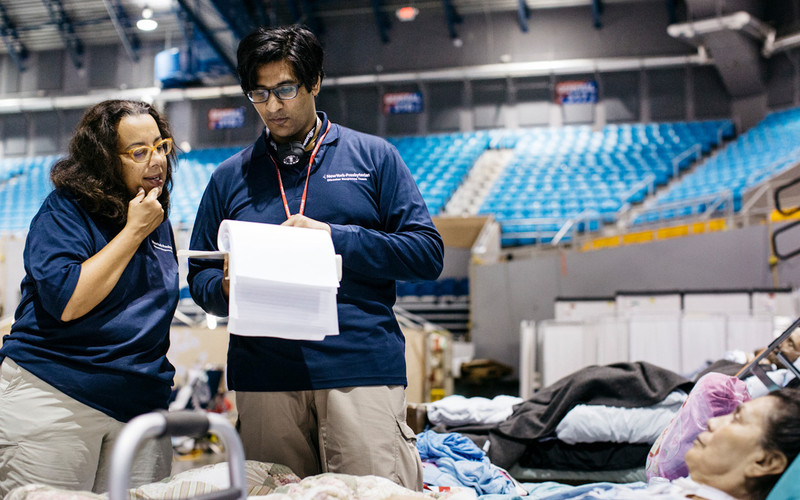"The quicker a doctor gets to the bedside, that’s when you see outcomes change. Absolutely, if we’re able to get a doctor there within minutes rather than hours, it makes a difference,” says cardiologist Chris Gallagher, co-founder and CEO of Access Physicians. Photography by Patrick Cavan Brown.
Why Telehealth Solutions Are Vital in a Disaster
When Hurricane Harvey hit Houston in 2017, some hospitals were effectively turned into islands, cut off from the rest of the city by floodwaters that covered low-lying roadways. As a result, many physicians were unable to drive to the hospitals where they worked, leaving patients to rely on whoever happened to be on duty when the waters rose.
Luckily, Access Physicians, a group that provides acute telemedicine care to hospitals around the country, was already working with a number of facilities in the area — including some smaller healthcare centers that had no physicians at all onsite at the time of the storm. During regular operations, Access Physicians typically provides specialty care. But in the wake of Harvey, the organization’s remote doctors assumed responsibility for the day-to-day duties of the hospitals’ regular physicians.
“We were able to get into hospitals that the flesh-and-blood physicians weren’t able to get to,” says cardiologist Chris Gallagher, co-founder and CEO of Access Physicians. “When the attending physician can’t make it to the hospital, you become the de facto physician because you are the only one who can get to the bedside. That was definitely a change in scope for us.”

Telemedicine is becoming increasingly important to providing care delivery during disasters. In addition to delivering routine care without putting patients in danger, physicians have used the technology to bring care where it’s too dangerous for doctors to travel. For example, relief agencies have relied on telemedicine to bring medical expertise to war-torn Syria and consult on cases during the Ebola outbreak in West Africa.
“These kinds of crisis situations tend to push the boundaries of telehealth a little harder,” says Jeff Becker, a senior analyst for healthcare strategy at Forrester.
MORE FROM HEALTHTECH: Discover five ways telehealth is taking modern healthcare to the next level.
Access Physicians Adopts New Technology to Solve Staff Shortages
Access Physicians uses 6-foot-tall telemedicine carts with an HD pan/tilt/zoom camera, a 27-inch Apple iMac, a Wi-Fi hotspot, a UPS and a digital stethoscope. After Harvey, one hospital lost electricity and had to rely on its generator for power. The hospital’s network also went out, but because Access Physicians’ carts include hotspots and iPad devices with data plans for redundancy, hospital staffers were able to connect using 4G.
The size of the carts is meant to replicate the experience of talking to a doctor face to face, says Erica St. Angel, chief technology innovation officer for Access Physicians. “We want that experience to be the same,” she says. “Our goal is that you don’t focus on the technology. That should melt away, and instead you focus on the relationship that the physician is building with you.”
Gallagher says that most of a doctor’s duties aren’t “procedural,” but instead center on taking in data, coming up with a diagnosis and developing a treatment plan that ultimately gets carried out by the rest of the clinical team. By virtually putting a physician in the room to lead an onsite team, Gallagher says, telemedicine has the power to improve patient outcomes both during and after a disaster.
“In our experience, reducing the time-to-encounter improves outcomes,” he says. “The quicker a doctor gets to the bedside, that’s when you see outcomes change. Absolutely, if we’re able to get a doctor there within minutes rather than hours, it makes a difference.”
NewYork-Presbeyterian Brings Care Where It’s Needed Most
After Hurricane Maria ravaged Puerto Rico in 2017, NewYork-Presbyterian Hospital (NYP) sent teams of physicians to the island, and officials asked Leo Bodden, vice president and CTO, if it would be possible to support the teams with telemedicine.
“At first, we actually laughed,” Bodden recalls. “They were flying out in a couple of days. We said, ‘We need connectivity, and there’s no electricity.’”
But with the help of Cisco Systems and the Federal Emergency Management Agency, NYP was able to establish internet connectivity through a satellite link. That allowed physicians on the ground in Puerto Rico to use their Lenovo laptops to connect back to specialists in New York through NYP OnDemand, the healthcare system’s telemedicine portal powered by Cisco Jabber. The physicians used the built-in cameras on the Lenovo machines or Microsoft LifeCam Studio cameras. “From there, it was business as usual,” Bodden says.
Dr. Shari Platt, chief of pediatric emergency medicine at NYP/Weill Cornell Medical Center, conducted a telemedicine session between an NYP physician in Puerto Rico and a pediatric subspecialist in New York. The provider in Puerto Rico was treating a 2-year-old boy with diabetes who had gone without insulin for two weeks due to lack of refrigeration, and wanted to consult an expert.
“Being able to see him was very, very important,” Platt says. “It’s a critical piece of the evaluation. Watching him breathe and observing him play, we had full confidence in our ability to guide his treatment plan.”
Platt adds, “We had a huge team of NYP providers in New York City ready to provide care to children in Puerto Rico, even though we weren’t physically there.”
WATCH: Healthcare providers are evolving the way they deliver care to patients.
Nemours Uses Telemedicine to Help Patients During Disasters
Late in the summer of 2017, while Hurricane Irma was battering Florida with 130 mph winds, pediatrician Patricia Solo-Josephson helmed a telemedicine station in Jacksonville, providing care to children whose parents didn’t want to risk driving through the storm to the hospital.
“I had parents call in with a 3-year-old who had a barky cough, and I diagnosed the child with croup,” recalls Solo-Josephson, a physician with Nemours Children’s Health System, which operates in five states in the Mid-Atlantic and Southeast. “Through the video, I was able to see that the child didn’t have any respiratory distress. I was able to alleviate their worry and save them a trip to the emergency room in Category 4 winds and through flood zones.”
Nemours began offering telemedicine services in 2015, using equipment from vendors such as American Well and Vidyo to support the hospital’s proprietary telemedicine app. Nemours has logged 20,000 patient visits, the bulk of which are for common childhood complaints such as fever, rash and upper respiratory symptoms. But, like officials at other healthcare systems that utilize telemedicine, Nemours physicians and IT staffers have realized that the technology is particularly useful during disasters, when seeking out routine care could otherwise be dangerous for patients and their families.
86%
Percentage of respondents who gave the Nemours Children’s Health System pediatric telemedicine program five stars.
“In general, during disasters, we try to keep families from getting out on the road if they don’t need to,” says Collin McQueen, telehealth technical and operations manager for Nemours. “We’re trying to keep families safe by bringing the care to them.”
During Hurricane Irma, Nemours fielded 262 telemedicine visits, with a mean patient wait time of just 12 minutes and an average satisfaction rating that approached five stars (out of five). In addition to bringing peace of mind to parents of sick kids, Solo-Josephson says, the use of telemedicine during a disaster helps to keep emergency rooms and ambulance services from being overwhelmed by routine cases. “Redirection of care is essential during disasters,” she says. “You want to make sure that the ER has the appropriate patients, and not tie up those services with children who don’t need them.”
Nemours has also used its telemedicine infrastructure to deliver care during a major blizzard in Delaware, and even offered assistance to families in Texas — far from the organization’s regular territory — during Hurricane Harvey. “We had the technology and the ability to do it,” says McQueen. “It was just a matter of turning it on. When the state of emergency was declared, we wanted to help if we could.”
Users can download the hospital’s telemedicine app to a mobile device, set up an account and see how many patients are waiting in front of them. Most have to wait only a few minutes before seeing a doctor. While some cases require an in-person consultation, of course, the app allows physicians to assess patients based on their movements, responses to certain tests and the look of their eyes and skin. “It’s really superior to the information you can get over a phone call,” McQueen says.














